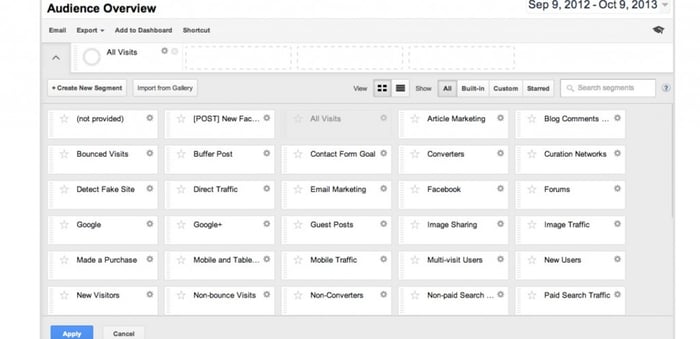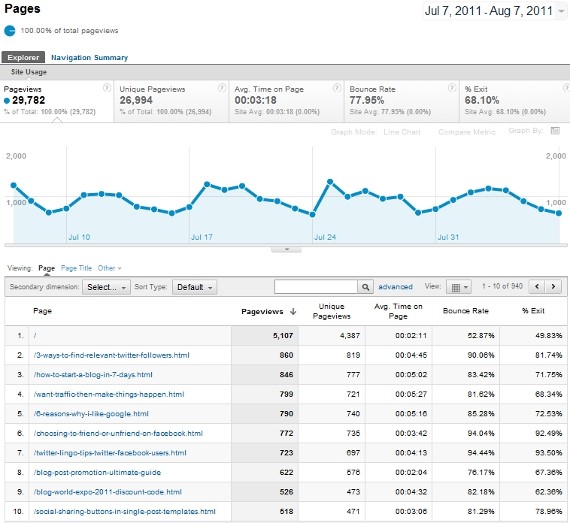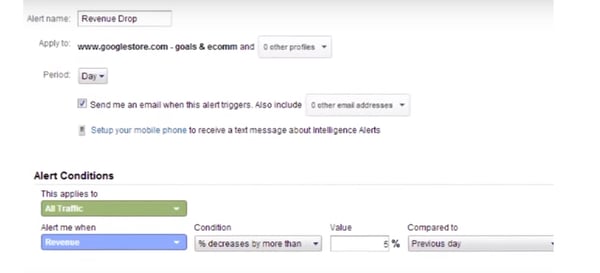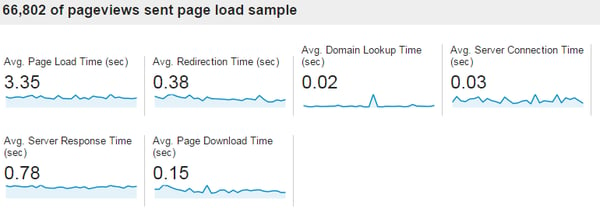
Google Analytics helps online business owners understand their customers’ behavior and conversion funnel performance; more importantly, it helps uncover opportunities for website improvements.
Used properly, Google Analytics can be one of your best tools, but if you are one of the 80% of retailers using Google Analytics incorrectly as of 2015, you’re missing out on information, insights, and income!
Here are the top 5 Google Analytics tips:
1. Advanced Segmentation
Audience segments help marketers understand the online behavior of clusters of site visitors. Google Analytics takes this methodology and enhances it. With advanced segmentation, brands can sort, search, and group their leads and customers according to specific criteria:
- Demographics
- Technology
- Behavior
- Date of First Visit
- Traffic Sources
Advanced segmentation offers insights that may change the way you relate to your users. For example, if you are interested in separating mobile users with screen resolutions under 600 from any of your reports (try checking if these users convert on your site), use this segment:
Include | Screen Resolution | Matching RegExp | (^[1-5]?[0-9]?[0-9])x([1-5]?[0-9]?[0-9]$)
2. What’s Hot & What’s Not
Online business people gain insight from looking at the pages that visitors spend the most time on and assessing how changes to those pages change the visit duration. Google Analytics masters look even closer at the pages that aren’t getting attention.
Understanding what doesn’t pique visitors’ interest will give you understanding into your customers’ psyches, along with an indication of which pages you need to reassess. After all, if the majority of users that are bouncing off your site are doing so from one particular page, that’s a giant red flag that requires your immediate attention!
By going to the Content menu and selecting Pages under Site Content, you can note which pages are -with a high bounce rate or low Avg time on page. Determine whether to invest resources in improving the pages or consider removing them altogether.
Which will better fit the demand of your customers?
Improving or removing under-performing pages invariably increase sales. Google Analytics Content Experiments can also help you determine which pages and content are most effective, by A/B testing variations. Now you can measure the success of each page version to determine the most effective one for each audience segment.
3. Intelligence Events
Online marketing is all about sending the right message at the right time. Google Analytics provides real-time Intelligence Events to constantly update you about your site’s traffic and visitors’ activities. Set your account to send pre-defined alerts when something needs your immediate attention.
For example, you can set the alerts to be sent to your phone when site visits drop dramatically or when there’s a spike in traffic from a specific region. You can create custom alerts, where you set the parameters that are relevant to you.
Keep yourself informed in real-time if your site experiences an unusual variation in the number of visitors, conversions, revenue, goal completions, and other metrics.
You can set up Intelligence Events by going to the Reporting tab, then going to any one of the Intelligence Events reports (Overview, Daily, Weekly, or Monthly Events). Once there, you will see a bar graph with a Custom Alerts field, where you will see the option to Create a Custom Alert.
4. Valuing Goals
Marketing is part art, and part science. The scientific part is mathematical, statistical, and fiscally responsible. By setting up conversion goals with Google Analytics, you complete the cycle from referrer to conversion. Only when goals are set up (and set up correctly using both macro and micro goals) can you truly get the data you need to make informed marketing decisions.
A macro goal is the main action you want users to take on your site: often it is to make a purchase or start a trial. A micro goal is other actions that are important to track that may eventually lead to a macro conversion, like watching a video, downloading a piece of content, or requesting a demo.
By tracking both, you empower yourself to create a multi-channel marketing effort that generates traffic at different points of the buyer’s journey – early stage (or “top of funnel”) visitors are more likely to convert on a micro goal, while later stage (or “bottom of funnel”) visitors will convert at a higher rate on the macro goal.
5. Site Speed
Technical issues surrounding the performance of your site are bad for the user experience (and also identified as bad by the Googlebots). Using Google Analytics’ Site Speed section enables you to gauge how quickly your web pages are loading so that you can identify (and fix!) any issues.
You may find issues with the time it takes the server to respond to the page request and the time it takes the browser to parse, download, and display the page.
Google Analytics will give you server connection time, server response time, redirection time, page download time, and many other important metrics. And then, it will also give you suggestions on how to improve your pages’ performance.
Better for the audience is better for you
Google Analytics provides important segments, metrics, and events. Understanding these allows you to cater your online marketing, website experience, and overall message to fit your audience and to achieve the highest levels of success.
Google Analytics Tools and Add-Ons
One of the tips for Google Analytics that you don’t hear enough about is that there is a great variety of add-ons and tools that enable you to use Google Analytics more effectively.
Some of these tools include:
Tag Assistant
Tag Assistant is a Google Chrome extension that helps you verify if you have properly installed Google tags on your pages. The add-on will automatically notify you of any errors and suggest improvements for your implementation.
Screaming Frog
Screaming Frog offers an SEO Spider tool that is able to crawl all websites efficiently and enable you to analyze your results in real-time.
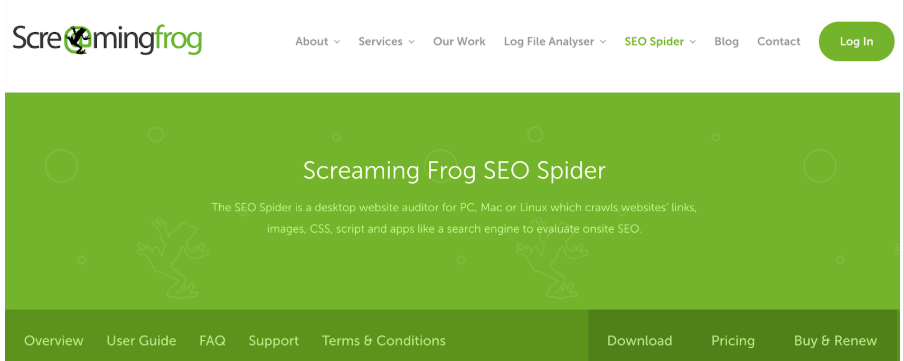
You’ll gain insight on:
- Broken Links
- Audit Redirects
- Page Titles and Meta Data
- Data Extraction with XPath
- XML sitemaps
- Duplicate Content
- Robots and Directives
- Integration with Google Analytics
Quill Engage
It’s not uncommon for most people to misunderstand their Google Analytics data. This is where Quill Engage comes in—they explain Google Analytics data in plain English via custom reports for you and your clients.
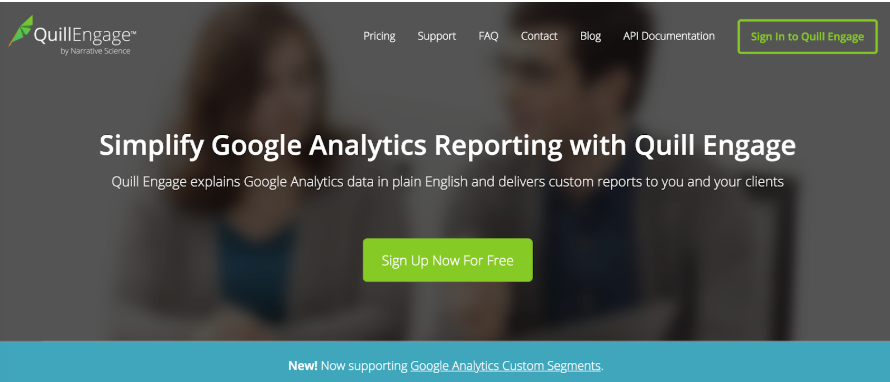
You’ll be able to instantly interpret and understand what drives your website performance with in-depth reports on:
- Referral Traffic
- Goals and Conversions
- Events
- Ecommerce
- AdWords
By analyzing Google Analytics data, you gain actionable insights to make improvements.
Are you looking for assistance with optimizing your website using Google Analytics? Contact us at KeyScouts today for a free consultation!



